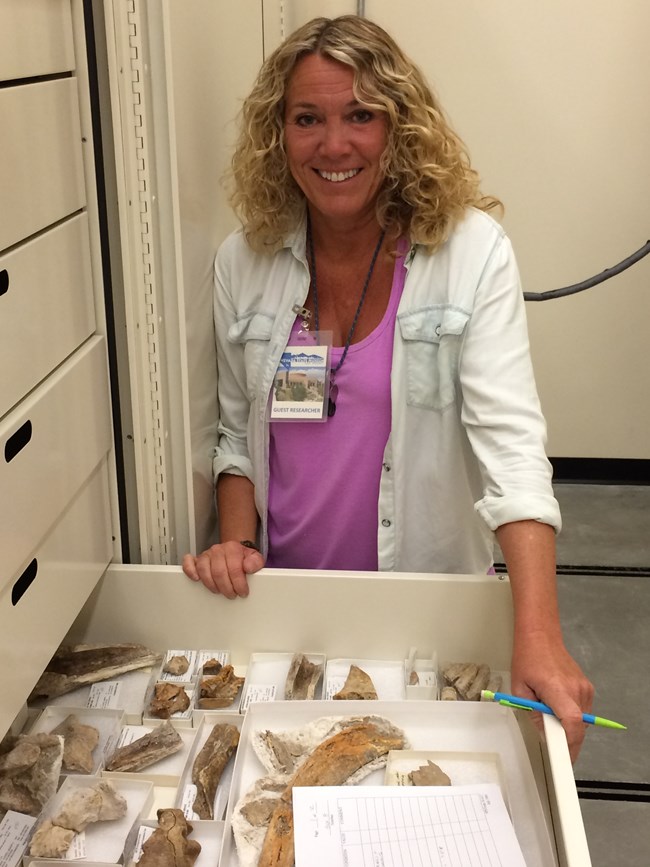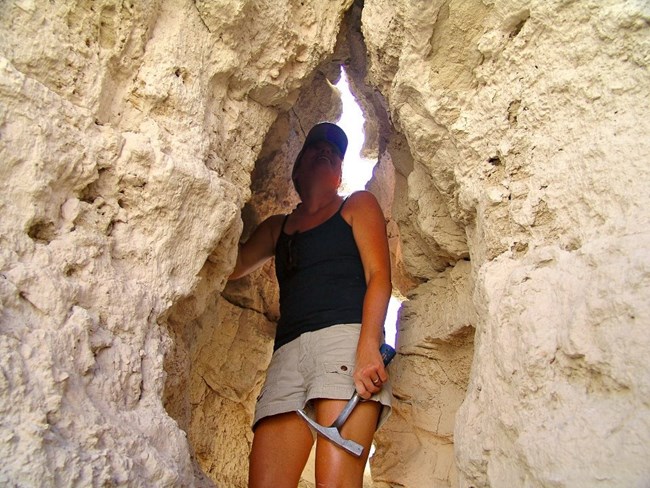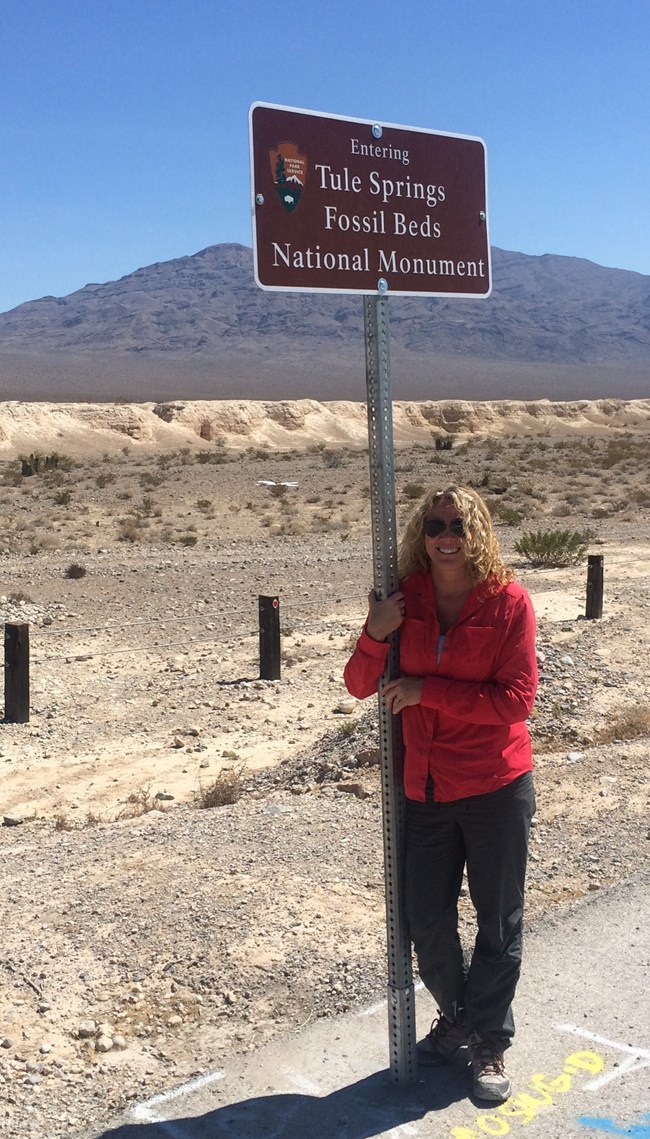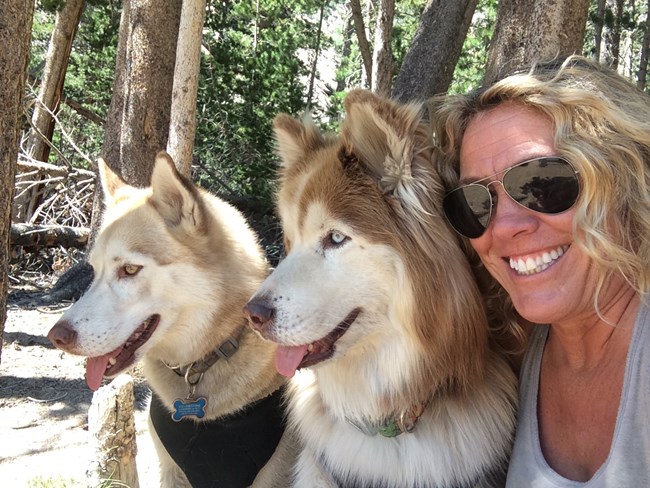Part of a series of articles titled Meet A Paleontologist.
Article
Kathleen Springer, U.S. Geological Survey

Geologist, U.S. Geological Survey, Pasadena, California
NFD Kid's Page Interview...
Please describe the type of work you do in paleontology:
My career path in paleontology has been varied and a little unusual. When I was in college, I worked on lower Devonian graptolites and conodonts as well as vertebrate fossils from Australia and the Mojave Desert. After graduation, I ended up at natural history museum in southern California, which was super lucky, since my dream was to work at a museum(!) There, I worked exclusively in the field of vertebrate paleontology – finding (mostly) late Pleistocene fossils, and learning more about what it takes to “curate” a fossil and work in museum collections. I also worked extensively on exhibits and geoscience outreach in my role as senior curator in geological sciences.
My specific interest in vertebrate paleontology is understanding the environments in which extinct animals – mammoth, mastodon, horse, camel, bison and sloth – lived and died. I have worked to understand the stratigraphy and chronology of the deposits that entomb fossils at sites all over southern California and Mojave Desert in an effort to make all of the collections in the museum meaningful to other scientists – to give the fossils a context.

What are you working on now?
I now work as a geologist at the U.S. Geological Survey. I work primarily on sedimentary deposits that represent late Pleistocene spring and wetland ecosystems – and the cool thing is that they all filled with fossils! Our team at the USGS is creating a really detailed framework of these environments through time and show how the ecosystems responded to past episodes of climate change. With this framework we can ask how the animals also responded to climate change.
I work all over the deserts of the American Southwest. At the moment, my work is concentrated on Tule Springs Fossil Beds National Monument in southern Nevada. Tule Springs is the linchpin of our wetland studies and there we have shown that the “fossil beds” that make up Tule Springs were marshes, meadows, and stream ecosystems that were home to mammoths, horses, camels, bison, sabre-toothed cats, and dire wolves. These ecosystems are very fragile and were extremely sensitive to climate change.

Where did you go to school? What were some of your favorite classes?
I consider myself a successful product of the community college system. At Riverside Community College, I was exposed to amazing instructors who provided that “light bulb” moment for me regarding what I wanted to do with my life, which was get a degree in geology and work at a museum! I then attended the University of California, Riverside, where I obtained undergraduate and graduate degrees in Geological Sciences, both with an emphasis in paleontology. My undergraduate degree included not only the usual geology curriculum, but also had a heavy biology emphasis. My favorite classes were igneous and metamorphic petrography (rocks under a microscope – awesome!) and functional anatomy of the vertebrates – such different topics, but pretty typical for me, since I love both rocks and fossils!
Was there an experience you had that made you realize you wanted to be a paleontologist?
Having a career that involved the outside world was the draw for me initially, and the big hook was being out in the field - looking for and collecting vertebrate and invertebrate fossils, and using all kinds of techniques to extract them. And ultimately, it was working in a lab, both at UCR and a museum that sealed the deal. I realized how gratifying it was to not only collect fossils in the field, but to extract fossils from solid rock (melt them in acid!) or washing sediment through screens – processes that took so long - but finally you got to sort them under a microscope, all of these teeny tiny little fossils (conodonts, microvertebrates) that lived so long ago and told a story. That was weirdly magical for me, the pursuit to obtain that knowledge. All of these early experiences were when I was a student, and the opportunities I was given, definitely molded my path.

What was your most memorable experience working with fossils?
During my entire career, in spite of finding fossils all over the place, what really gets me excited is the ability to interpret fossils and the history of life to the public. When I stand in front of a spectacular mammoth tusk, for example, all I can think about is “how can we tell this story?” Scientists who get the opportunity to exhibit or interpret fossils to the public need to convey not only where they came from and how old it is, but what that animal did for a living, what the environment was like in which they lived, and how the bones became fossils. All of these stories have to be intertwined with the object in an engaging, educational and entertaining way. So for me, designing museum exhibits has always been an incredibly rewarding experience
Working on an exhibit, from the idea of what we wanted to display and how we wanted to tell the story, to its final design and when it is built, seeing the vision and the fossil come alive – and then watching the light bulb go off for a child or adult when they see it for the first time, always makes me smile.
Do you have any advice for aspiring paleontologist?
Pursue a degree in the geological sciences so that you can read the rocks that contain the fossils. I am fairly militant about this as it is vitally important for a paleontologist. Take as many classes in the biological sciences as possible, but understanding the geologic template for biologic innovation through time is the key to understanding paleontology.
Last updated: August 22, 2017
